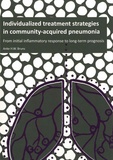Individualized treatment strategies in community-acquired pneumonia
From initial inflammatory response to long-term prognosis

Bruns, Anke
- Promoter:
- Prof.dr. A.I.M. (Andy) Hoepelman
- Co-promoter:
- Dr. J.J. (Jan Jelrik) Oosterheert
- Research group:
- Hoepelman , Oosterheert
- Date:
- September 24, 2010
- Time:
- 14:30 h
Summary
Community-acquired pneumonia (CAP) is one of the most important causes of hospital admissions and together with influenza the third leading cause of death worldwide. Moreover, treatment of CAP largely contributes to the global burden of antibiotic resistance. In present thesis, we explored options for individualized treatment of CAP, in a spectrum from initial inflammatory response to long-term prognosis. In the past years, the genetic risk for infection has been regarded as an increasingly important determinant of CAP. We provide an overview of the enormous amount of genetics variations (polymorphisms) in diverse inflammatory genes, leaving no doubt that there is a genetic basis for susceptibility to or outcome from CAP. Unfortunately, none of them has lead to any clinical applications yet. As a first step in translation of statistical association into clinical practice, we report a functional polymorphism in the TFPI gene associated with a benificial response to adjuvant treatment with rTFPI for severe (pneumo)sepsis. Theoretically this polymorphism can be used to select individuals for adjuvant treatment. Procalcitonin (PCT) testing is also mentioned as a promising strategy to better select individuals necessitating antibiotics and hereby reduce antibiotic prescriptions, especially in primary care setting. For another biomarker, C-reactive protein (CRP), we show that normalization patterns may help to determine appropriateness of antibiotic treatment. Therefore, consecutive CRP measurements seem useful in the first week of follow-up to select patients unresponsive to initiated therapy. Concering antibiotic treatment, equality of the advised empiric antibiotic strategies for in-hospital treatment of CAP in terms of selection for Clostridium difficile (C. difficile) is unclear. The data suggest that not a particular group of antibiotics but more individual determined risk factors, such as duration of antibiotic treatment or previous hospitalizations, are associated with nosocomial C. difficile acquisition. Another important topic in antibiotic treatment for CAP is the time to first antibiotic dose (TFAD), which has been implemented as performance indicator for all CAP patients. Our data show that for individuals admitted to general wards -in contrast to those necessitating treatment in the ICU directly- one can take time to establish a reliable diagnosis before administration of antibiotics. We also studied the resolution of radiographic abnormalities in patients with mild to severe CAP. Radiological clearance rates were 56-70% after one month and lag behind resolution of symptoms. Therefore, monitoring a favorable disease process by routine follow-up chest radiographs leads has no additional value above following a patient’s clinical course. Finally, we show that long-term mortality rates after an episode of CAP are high; up to 53% after 7 years and considerably higher than in a matched population cohort. In the long-term, ex-pneumonia patients seem more likely to die because of co-morbidities than recurrent pneumonia. These insights in causes of death on the long-term may offer new targets for individual risk profiling and prevention.